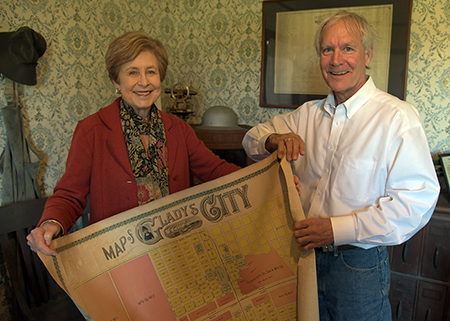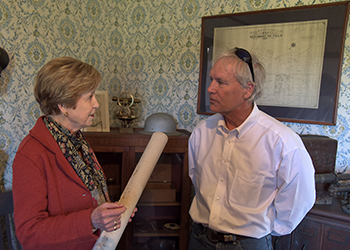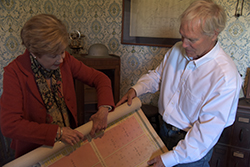Original 1892 Gladys City map donated to LU
A piece of history came home this week when Kit Herrington of Corsicana delivered an original map of Gladys City as envisioned by entrepreneur Pattillo Higgins to Lamar University, home of the Spindletop-Gladys City Boomtown Museum.
 The map, printed in 1892, was used by Higgins to sell lots that helped finance the first drilling effort at Spindletop Hill. That effort, and several subsequent efforts, failed. While Higgins’ vision as presented in the map was never realized, he is credited with recognizing the potential for oil and starting the process that changed history on January 10, 1901 when the Lucas Gusher came in.
The map, printed in 1892, was used by Higgins to sell lots that helped finance the first drilling effort at Spindletop Hill. That effort, and several subsequent efforts, failed. While Higgins’ vision as presented in the map was never realized, he is credited with recognizing the potential for oil and starting the process that changed history on January 10, 1901 when the Lucas Gusher came in.
“It’s a treasure, it really is,” said Ellen Rienstra, who accepted the map on the university’s behalf. A sixth-generation Southeast Texan, lifelong resident of Beaumont and LU alumna, Rienstra is co-author of “Giant Under the Hill: A History of the Spindletop Oil Discovery at Beaumont, Texas, in 1901” and “The Long Shadow: The Lutcher-Stark Lumber Dynasty,” and other works of history.
With ancestral ties to Beaumont, Herrington has always had a keen interest in the area’s history. His parents were the late Tommy Herrington and Ann (Williford) Herrington of Beaumont and his grandparents were Lois Williford and Dr. H.B. Williford, originally of Fairfield and a pathologist in Beaumont from the 1930s to the 1980s. Several years ago, he invited Rienstra to speak at to the Corsicana Rotary Club about her research into the history of the Lutcher and Stark family. Lutcher Stark presented the charter to the Corsicana Rotary Club in 1921. In 1901, the Hamill brothers of Corsicana used their drilling skills to bring in the Lucas Gusher on Spindletop Hill.
 Lamar University is home to the Center for History and Culture of Southeast Texas and the Upper Gulf Coast, and the Spindletop-Gladys City Boomtown Museum, a recreation of what Gladys City would have looked like during the first oil boom.
Lamar University is home to the Center for History and Culture of Southeast Texas and the Upper Gulf Coast, and the Spindletop-Gladys City Boomtown Museum, a recreation of what Gladys City would have looked like during the first oil boom.
The map, given by Herrington in honor of the late Judge James D. McNicholas, former mayor of Beaumont, and Dr. Thomas A. Lombardo, Beaumont cardiovascular specialist, is in remarkably good condition.
Herrington was encouraged to donate the map to Lamar by the late Michel T. Halbouty, geologist, petroleum engineer, wildcatter and author. "When I met him he was in his 80s and still golfing," Herrington said. Halbouty shared with him how, as a student at Dick Dowling Jr. High in Beaumont, one of his teachers encouraged him to study geology when he'd asked how the earth had changed through the years. That conversation sparked an incredible career, Herrington said.
The Pattillo Higgins story is “endlessly fascinating,” Rienstra said. “Higgins grew up in Beaumont, then a rough sawmill town, and he was a real ruffian.” Higgins killed a Marshall in a gunfight in which he was seriously injured. Although tried and acquitted by a local jury, he forever carried a reminder of that conflict — he had lost an arm to amputation.
“Later Higgins experienced a religious conversion and became as militant a born-again Christian as he had been a ruffian,” Rienstra said.
“His character was one of fractiousness and bellicosity all of his life,” she said. “He was a contrarian. His great nephew wrote ‘there was a great cultural and technological gap between the world as conceived by Pattillo Higgins and the world in which most people of the area thought they lived.’”
“He was also very smart,” Rienstra said. Higgins was in the brick manufacturing business and, on visit to the East Coast in search of a new kind of fuel, when he recognized the same geological signs in the eastern oil regions as he had seen at Spindletop Hill. “So, he thought there was bound to be oil there,” Rienstra said. His plan was to use this abundant fuel to power a well-planned industrial city.
Pattillo Higgins envisioned Gladys City before drilling ever started at Spindletop. The town was named after Gladys Bingham, a girl in Higgins' Sunday School class.
 On the map donated by Herrington, one of the original copies that Higgins had made for the mythical Gladys City, are depicted locations for churches, schools, hospitals as well as industrial areas and active oil fields. “Those things only existed in Higgins’ mind,” Rienstra said.
On the map donated by Herrington, one of the original copies that Higgins had made for the mythical Gladys City, are depicted locations for churches, schools, hospitals as well as industrial areas and active oil fields. “Those things only existed in Higgins’ mind,” Rienstra said.
The Gladys City that actually came to be was far different, Rienstra said. After the Lucas Gusher blew in, the area that was designated for Gladys City grew up quickly. It was not the model town that Higgins had planned but it was one of the tamer parts of the oil field. “It was the cleanest and most respectable part of the hill, which says little,” she said. “Still, it was a rough place and nothing like the industrial utopia he conceived.”
Today’s Spindletop-Gladys City Boomtown Museum is, in effect “the third incarnation of Gladys City,” Rienstra said.
For more information on the discovery of oil at Spindletop and Pattillo Higgins’ role in it, visit https://www.lamar.edu/spindletop-gladys-city/spindletop-history.html.


